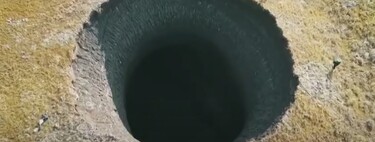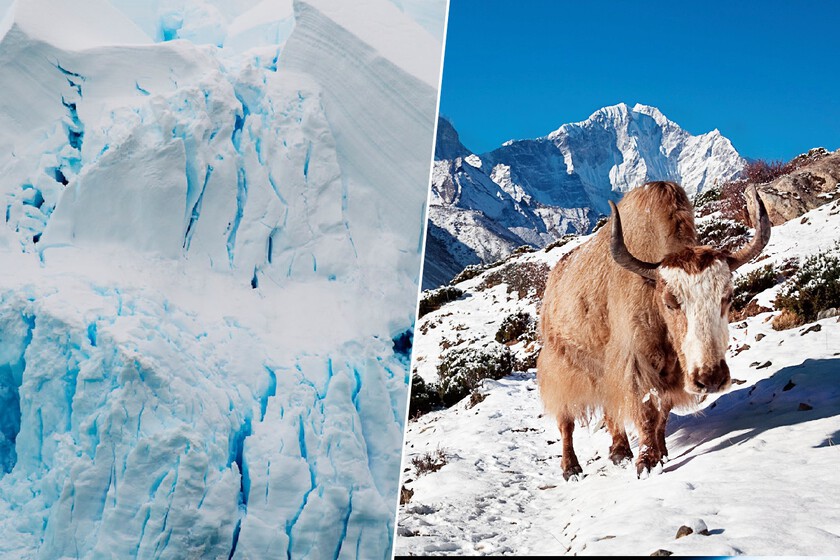The concept of “zombie virus” in a scientific key is not so different from what you might find in an HBO series. We’re talking about ancient viruses that have lain dormant or dormant for thousands or even millions of years, but could be “reanimated” and, if necessary, become infectious again or simply show us a unique window into the past. That is what have found at an altitude of more than 6,000 meters in the Himalayas.. They have just been brought down, and analyzed.
Research. The story goes back to 2015, at which time an international team of researchers ventured to the remote Guliya glacier on the Tibetan Himalayan plateau to collect hundreds of meter-long ice cores. It so happened that, trapped inside the ice, there were more than 1,700 species of virusesalmost all of them new to science.
Now, a study published in Nature Geoscience provides scientists with a snapshot of how these viruses have adapted to changes in climate over millennia. It is also an attempt to protect information stored in permafrost that is no longer permanent. Soil that has been frozen for thousands of years is thawing due to climate change, and these “zombie viruses” may contain thousands of clues.
Moving ice cores. Just as they tell in their workextracting and studying one of these ice cores is not an easy task. To extract them, an expedition team was required to travel to the Guliya plateau more than 6 kilometers above sea level. They also needed to be accompanied by local yak herders, known as Tibetan whistlers, and herds of these creatures to transport the heavy cores.
Then, using a special machine that holds them in one piece inside the drill, a 10-cm-wide circle is carefully drilled more than 300 meters into the ice, corresponding to 41,000 years of history. The next step involved cutting into meter-long sections for transport on yaks, then to freezer trucks, and finally an airplane before the precious cargo arrived at a laboratory, in this case a research institute in Columbus, Ohio, where they “rest” the cores deep in a -31 degree Celsius freezer.
Life and climate change. “Three of the ice cores in our collection come from glaciers that no longer exist in the real world.” explained Lonnie Thompson, a researcher at Ohio State University. “Our mountaintop glaciers and the history they contain are disappearing at an accelerating rate as global temperatures continue to rise.”
However, within these boulders is a treasure trove of precious treasure. They discovered the genetic information of 1,705 viral species across nine ancient time periods. Viruses they have analyzed and found to be bacteriophages, i.e., types that infect only bacterial and archaeal species, not humans, animals or plants. In addition, 97% of the viruses in the ice were new to science.
An unprecedented finding. Put another way, the discovery at the top of the Himalayas increased 50-fold the amount of viral information from permafrost that scientists had previously collected. The researchers analyzed how these bacteria-infecting viruses changed with time and temperature variations over those 41,000 years.
According to ZhiPing Zhong explainedfirst author of the study, “These time horizons span three major cold-to-warm cycles, providing a unique opportunity to observe how viral communities have changed in response to different climatic conditions. By studying these ancient viruses, we gain valuable information on viral response to past climate changes, which could improve our understanding of viral adaptation in the context of ongoing global climate change.”
DNA from the past. They extracted as much DNA as they could from nine sections of the 310-meter-long ice core, each representing a different time horizon and climate period. The most recent sample was from as recently as 160 years ago, and the oldest from more than 41,000 years ago.
Taking all the DNA from each sample in bulk, they used a process called metagenomic analysis to select as many individual virus strains as they could from the resulting genetics.
What did they find? That the viral community looked significantly different depending on the climatic conditions captured at each depth and time in the ice core. “We saw clear changes in the viruses that existed in colder climates compared to warmer climates,” explains Matthew Sullivan, co-lead author of the study.
For example, during past cold periods, the Guliya Glacier viral community tended to revert to a similar, though not identical, composition. Instead, each warm period had a completely different set of virus species.
Most surprising mix. And of all the viruses analyzed, the most diverse in terms of microbes occurred about 11,500 years ago, during the transition from the Last Glacial Stage to the stable, temperate Holocene. That time period “shared the fewest viruses with all the other samples,” Sullivan recounts. “It’s interesting because it was a big time in this 41,000-year period.”
The importance of climate. Apparently, it was “the most dramatic change in climate” of that time span, and seeing it reflected in the viral community indicates how closely climate and microbes are linked, and how climate can influence the course of an ecosystem, from microscopic viruses infecting microscopic bacteria to everything in between.
These viruses are often trapped in environments such as permafrost or deep ice sheets. In fact, with global warming and the thawing of permafrost, there is concern that some of these ancient viruses may thaw, awaken and potentially cause new diseases, as they would not have been exposed to modern humanity and its immune systems, which could have unpredictable consequences for global health.

In theory, there is nothing to worry about. Yes, ancient viruses trapped in permafrost for tens of thousands of years have the potential to infect humans and spread around the world, but researchers don’t seem to be too worried, at least in this case, about triggering the next pandemic. “Glaciers represent some of the cleanest environments on Earth. They contain extremely low biomass.” explain the researchers.
In fact, the scientists even went so far as to routinely drink meltwater when drilling ice cores. That they are bacteriophage viruses changed everything and, as they point out in the study, “we should be much more concerned about … the evolution of new things rather than old things coming back,” they say.
Image | Pedro Szekely, Rudy Ayala
In Xataka | We have 13 viruses extracted from the permafrost and resurrected in the laboratory. The problem will come from the ones that escape.
In Xataka | Russia has found a wolf frozen 44,000 years ago “in perfect condition”. First decision: open it
On Xataka |
